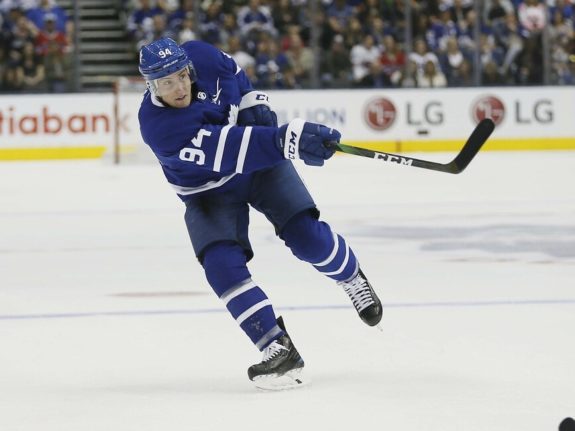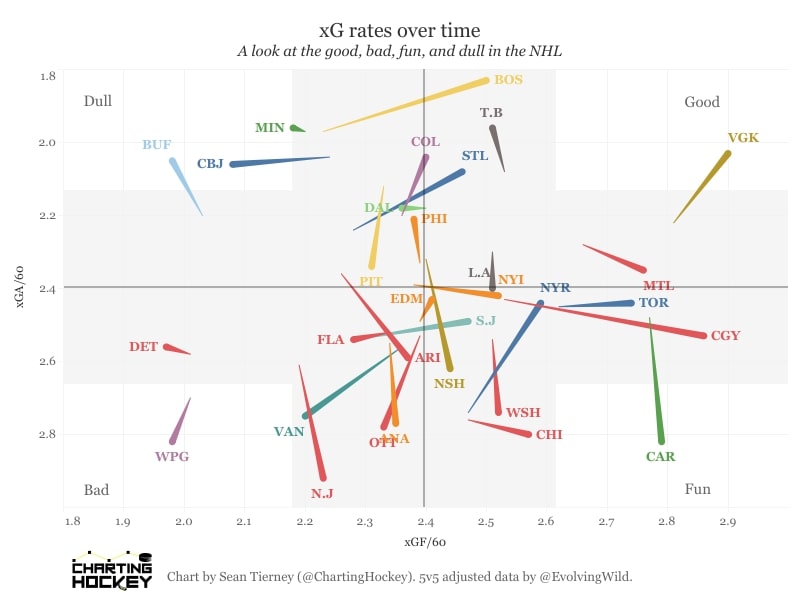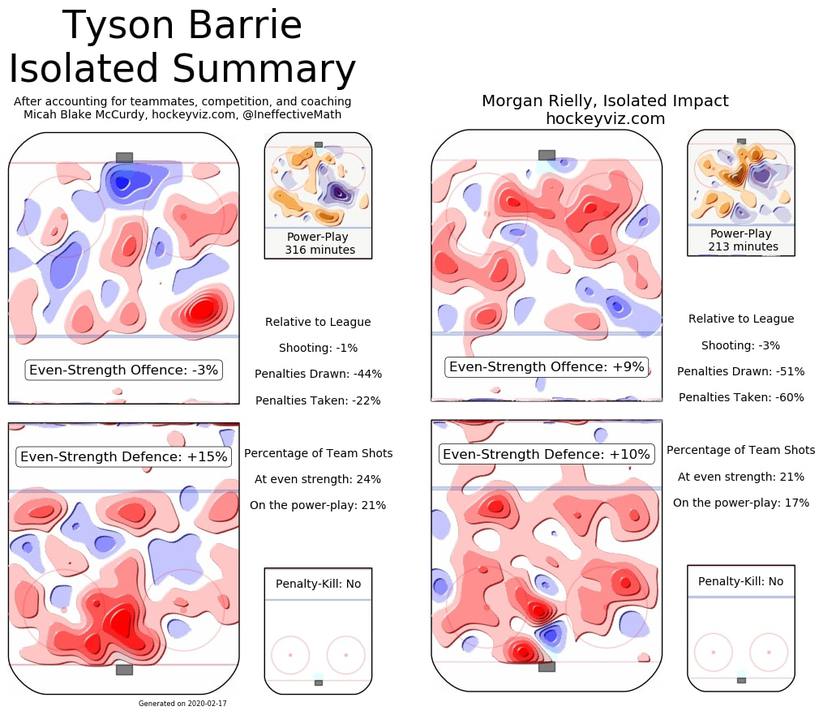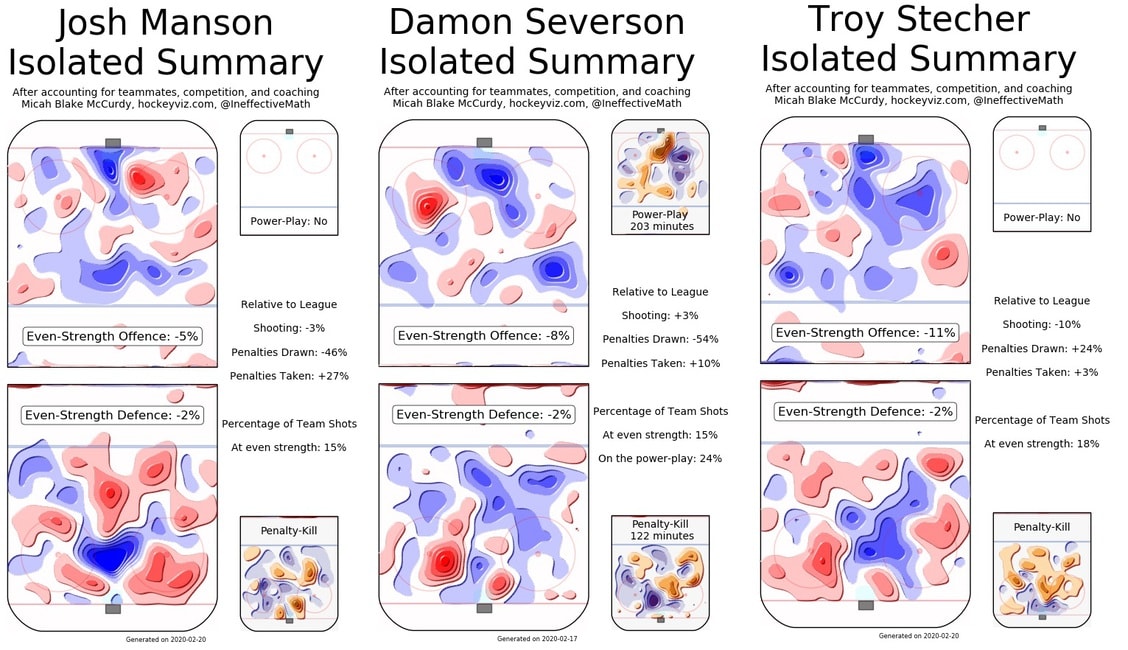In a July 1 blockbuster trade that sent Nazem Kadri, Calle Rosen, and a 2020 third-round draft pick to the Colorado Avalanche, the Toronto Maple Leafs acquired Tyson Barrie (50% salary retained) and Alexander Kerfoot. Barrie has been a polarizing player all season long.
Underutilized by former coach Mike Babcock, Barrie put up terrible numbers to start the season. In 23 games (under Babcock), Barrie scored zero goals and added only seven assists, on pace for 25 points over a full season, by far the lowest of his career.
With new life under Sheldon Keefe, Barrie has responded with five goals and 21 assists in 39 games, good for 55 points over an 82-game season. In fact, he ranks 13th among NHL defencemen in points since Keefe became the Maple Leafs’ coach.
Related: Sheldon Keefe Implementing Dubas’ Vision
However, Insider Trading reported on Feb. 20, 2020, that the Maple Leafs are listening to calls on Barrie, but that they wouldn’t move him for futures. They want to get better now.
Related: Maple Leafs News & Rumors: Andersen, Matthews, Leafs as Sellers?
Bob McKenzie reported that two situations would make the Maple Leafs want to move Barrie: First, the return is a defenceman who immediately makes them a better team; Second, they receive a package of prospects and draft picks who can then be flipped for another right-handed defenceman capable of playing alongside Morgan Rielly.

By breaking down Barrie’s play, we can consider how trading him would impact the Maple Leafs’ defence, from a statistical point of view, and offer some possible trade partners.
Breaking Down Barrie’s Play
Many people believe that the Maple Leafs’ defence is among the worst in the league. While some nights they look particularly ugly in front of their goaltender, their defence is not as bad as many believe.
Related: Maple Leafs’ Potential Trade Pieces
Below is a chart created by Sean Tierney that shows how expected goal (xG) rates change over time. As you can see, the Maple Leafs consistently improve on their xGF while keeping their xGA rates relatively constant. In fact, their xGA rates are only slightly worse than league average (indicated by the grey horizontal line).

Barrie’s on-ice xG share since Keefe took over is a respectable 53% at 5v5. However, this doesn’t tell the whole story.
He is an excellent puck-mover and great at jumping in to join the rush, but he often looks lost in his own zone. Getting pressured down low when he has the puck usually leads to a turnover, which is not something you want from your top-pairing defenceman.
Related: Maple Leafs News & Rumors: Muzzin, Andersen, Malgin & Barrie Trade?
The Maple Leafs’ other offensive defenceman is Rielly, who also struggles in his own end. But, below is a graphic which shows their individual offensive and defensive ability relative to league average.

According to the model, Barrie’s individual defensive impact is horrendous (15% worse than league average), and his offensive impact is below league average as well (3% worse).
Most of Barrie’s value comes from his ability to quarterback the power play, which he has done successfully over the past few months. Since taking over duties on the Maple Leafs’ top power-play unit, they have climbed the ranks and now have the third-best power play league-wide (24.4%).
On the other hand, Rielly’s defensive impact is also terrible (10% worse than average), but his positive offensive impact (9% above average) helps to outweigh the negative.
For reference, on the heat map indicating the Maple Leafs’ overall 5v5 defence, they come in at a +4% threat, only slightly worse than league average (as mentioned above). There is a big difference between +15% and +4%, so Barrie’s troubles in his own zone are not understated.
There are a number of names being floated around as possible trade targets for the Maple Leafs. Not all of them would require trading Barrie, but I want to detail some of the more popular options:
Possible Trade Partners
The three defencemen whose names come up the most are the following:
- Josh Manson: One goal, five assists in 41 games. Advanced stats are 51.01 CF%, 48.67 xGF% at 5v5 on the Anaheim Ducks
- Damon Severson: Seven goals, 15 assists in 60 games. Advanced stats are 48.53 CF%, 48.97 xGF% at 5v5 on the New Jersey Devils
- Troy Stecher: Three goals, eight assists in 60 games. Advanced stats are 47.79 CF%, 44.64 xGF% at 5v5 on the Vancouver Canucks
While all of these players are boasting relatively poor underlying numbers, their teams are all negative in terms of xG share (as you can see in the above graphic, they are all in the “bad” quadrant). These numbers, however, do not tell the whole story.
What is their individual impact compared to Barrie?

As you can see, they are all much better than Barrie defensively, albeit slightly worse offensively. Josh Manson tops the trio, with the best offensive impact. He would make a great acquisition for the Maple Leafs.
With regards to contracts, both Manson and Severson are signed beyond this season with a near equivalent cap hit ($66,000 is the difference, around $4.1 million AAV). Stecher is an RFA at the end of this season and is likely due for a raise from his current $2.325 million AAV contract.
The Maple Leafs can afford any of these three players given the cap relief they’ve built up through LTIR use, but would the price be too high?
Of the three, Stecher may be the most likely trade target as it has been reported that the Canucks have interest in Barrie.
There hasn’t been much reported about Severson, although the Devils are in the process of dismantling their roster. Who knows what could happen? If the Maple Leafs target Severson, Barrie wouldn’t be going back the other way. The Devils want to stock up on draft picks and prospects, not rental players.
Manson may be the most unlikely, as Anaheim has said they won’t be trading him unless they get, “blown away out of the water” by an offer, as reported by David Pagnotta.
This likely means that Toronto would need to include another roster player, or a combination of picks and prospects to sweeten the deal. For a team that is struggling to find offence from its bottom-six, how much are you willing to subtract from them to get the deal done?

In any event, the cries for the Maple Leafs to improve on defence are, in my opinion, slightly overstated. However, there is no denying that it’s far from perfect.
A lot of heat has come down on Barrie, as he has failed to meet expectations set when he was acquired this past summer (in the opinion of many). With the Maple Leafs listening in on trade calls, it will be interesting to see how things play out over the next few days.
Will he be moved as part of a deal to help bolster the team’s back-end or will he remain on the roster for the rest of the season, helping the Maple Leafs make a push for the playoffs in Rielly’s absence?
Stats courtesy of Natural Stat Trick.
Get the latest 2020 NHL Trade Deadline news, rumors and analysis